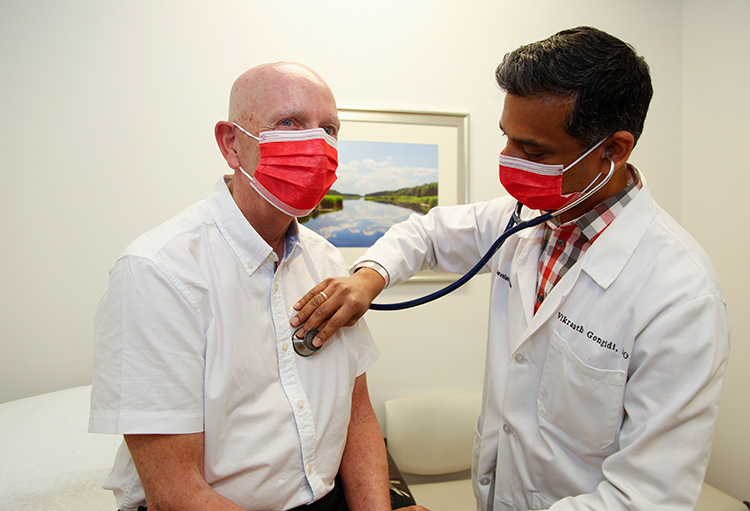
“The A-Team of cardiologists at Cleveland Clinic Indian River Hospital literally saved my life,” said David Wallace, who last December became the first patient to undergo an advanced “valve-in-valve” heart valve replacement procedure at the hospital.
After he was admitted to the emergency room with pneumonia, the emergency doctors determined Wallace’s heart function was only 20 percent of what it should have been, and he was referred to cardiologist Dr. Gongidi.
As a general cardiologist, Dr. Gongidi coordinated the A-Team of doctors that included Dr. Mariano Brizzio, an interventional cardiologist, and cardiac surgeon Dr. Carlos Lengua-Gonzales. Together they determined that Wallace’s previously replaced valve was not functioning properly and needed to be replaced once again.
“Mr. Wallace had an artificial heart valve that had been put in 10 years ago and, unfortunately, it was failing,” Dr. Gongidi explained. “Most of these artificial valves were meant to last about that long, and now with people living longer the valves are no longer effective. It’s a hard thing to do because once you open the chest to do valve replacement, there’s a lot of scar tissue underneath and to go back in is always risky.
“In his case we collectively decided that a newer, less invasive procedure called valve-in-valve replacement was the best solution for Mr. Wallace. Normally we would have sent him down to Miami or Gainesville or some other University Center. But with our highly qualified team, we knew we could do it here in his hometown.”
Valve-in-valve (ViV) transcatheter mitral valve replacement is performed by implanting a transcatheter heart valve within a failing bio prosthetic valve. “It allows us to insert a new valve made from pig or cow tissue into the old valve without ever opening the chest,” Dr. Gongidi said.
The procedure is done in the operating room with the patient anesthetized and put on a ventilator. The surgeon makes a small incision in the femoral artery in the right groin area and inserts a catheter into the heart and makes a small hole to cross the atrium from the right side to the left side. The surgeon then enters from the top down to put the new valve into the old failing valve.
Once the new valve is placed and expanded, it pushes the old valve leaflets out of the way and the tissue in the replacement valve takes over the job of regulating the blood flow. Typically, the patient will spend less time in the hospital after this procedure compared to more invasive surgical valve replacement.
“I liken the valve-in-valve replacement procedure to a set of Russian dolls where you put one doll inside another,” Dr. Gongidi said. “Over time there’s a limit to how many valves can be inserted based on the patient’s anatomy and the size of their heart. The valves come in different sizes, so we take multiple pictures with ultrasounds and CT scans of the chest to measure the valve area. We do our best to estimate the size, but we do have different sizes at our disposal if we have to size up or down.”
Valve-in-valve replacement patients require extensive post-operative care and physical rehabilitation, so they need a solid support system, which makes local treatment advantageous.
It would have caused added emotional and financial strain for the Wallace family if he had been sent to a distant facility for the operation. Now, with Cleveland Clinic Indian River doing the procedure, patients here can be treated locally, with family members close by, walk out of the hospital in five to seven days, and go home to familiar surroundings.
Dr. Gongidi emphasized the importance the comprehensive team approach used at the hospital. This procedure required the care and expertise of a general cardiologist, an interventional cardiologist and a highly skilled cardiac surgeon with specialized training in valve-in-valve replacement. No one doctor could have done it alone.
“The doctors made me feel comfortable throughout the entire process,” Wallace said. “The entire team sat down with me and went over all the particulars and risk factors and ultimately ended up saving my life.
“Not only were they able to do the surgery, but they were prepared for the emergency that happened when I went into cardiac shock after the procedure, and they had to take me back into the operating room to insert a temporary heart pump.
“I could hear them barking orders like they were prepared for this. I was terrified, but then I could breathe again, and I felt an inner peace. When I was returned to my hospital room I saw a beautiful rainbow out my window and knew I had been blessed.
“These doctors are heroes to me and without their expertise I wouldn’t be here. My son is getting married next week, and I will be there. I am forever grateful to the doctors and staff at Cleveland Clinic Indian River Hospital. My heart is functioning at about 35 percent now and improving, and I feel like I’m good for another 10 years or so.”
Dr. Vikranth Gongidi completed his undergraduate studies at the University of North Carolina, Chapel Hill, and his internal medicine internship and residency at Botsford Hospital in Farmington Hills, Michigan. He went on to complete his cardiology fellowship at the University of Medicine and Dentistry of New Jersey in Stradford, New Jersey. He can be reached at Cleveland Clinic Indian River Hospital’s Health and Wellness Center, 3450 11th Court, Vero Beach. He also sees patients one day a week at Cleveland Clinic Indian River Hospital’s Cardiology practice in Sebastian. Call 772-388-5402 for an appointment.



